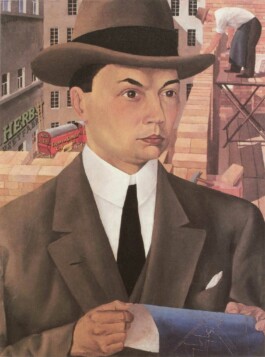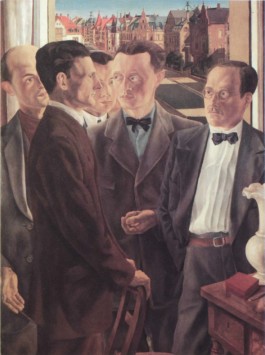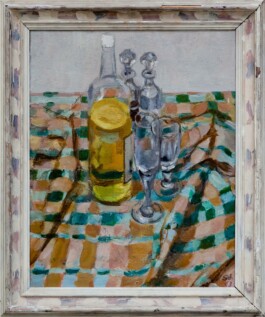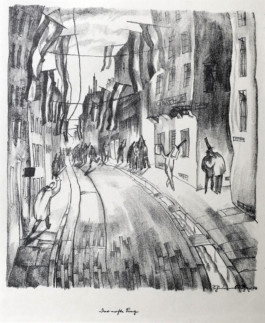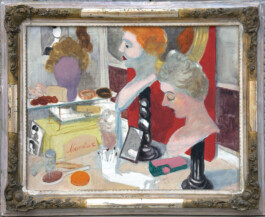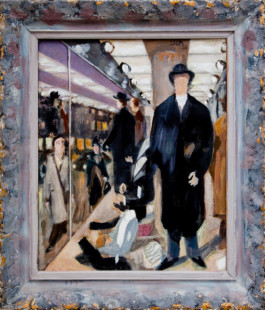WILHELM SCHNARRENBERGER
"It is true that one senses the painter's joy in the thing, and the desire to pursue delightful forms and compose color sounds. But one also senses his knowledge that the appearance is not everything, that there is something behind it, which the brush tries to foreshadow. Moreover, one senses the lover's distance from all these pretty and charming appearances: Masks play a role, wigs and props lead an independent existence and announce that this artist transforms the human world through humor or even through the ironic pleasure of the expert."
Lotte Paepcke, catalog, p. 57
Biography
Wilhelm Schnarrenberger (*30 June 1892 in Buchen (Odenwald), grew up in Bruchsal and Freiburg), studied graphic arts at the Kunstgewerbeschule Munich from 1911. After his studies, print commissions followed, as well as publications for magazines such as "Das Plakat" or "Simplicissimus", and numerous illustrations for publishers. At the same time Schnarrenberger also began to work as a painter. After participating in exhibitions at the Munich Neue Secession, he was appointed in 1920 as a teacher of commercial art at the Badische Landeskunstschule in Karlsruhe, where he later became a professor. After an Expressionist phase, his painting changed to an increasingly clear style, which became known as "Neue Sachlichkeit" (New Objectivity) in 1925 through the pioneering group exhibition organized by Gustav Friedrich Hartlaub at the Mannheim Kunsthalle. Schnarrenberger participated in this exhibition with six works. After divorcing his first marriage in 1927, he married the artist Melitta Auwärter in 1930. One year later their daughter Vera was born. As a result of the Nazi takeover, Schnarrenberger lost his professorship and the young family moved to Berlin. After his participation in an exhibition at the Märkisches Museum in Witten/Ruhr in 1937, Wilhelm Schnarrenberger's paintings were considered degenerate.Shortly thereafter, the family acquired a vacation guesthouse in Lenzkirch in the Black Forest, the operation of which provided a living. Through his wife Melitta Schnarrenberger continues to receive painting funds and can continue his artistic work. The marriage was divorced in 1946, Schnarrenberger returned to Karlsruhe and was allowed to resume his professorship a year later. In 1950 he marries Michaela Aust, née Bonheim. He becomes a member of the Badische Secession and receives the Hans Thoma State Prize in 1962. An invitation to be guest of honor at the Villa Massimo in Rome, where he had already been a guest in 1934/35, he was unable to accept for health reasons. Wilhelm Schnarrenberger died in Karlsruhe on April 17, 1966.
Collections and exhibition participations
Wilhelm Schnarrenberger is represented in numerous collections. These include the Staatliche Kunsthalle Karlsruhe, the Museum für Neue Kunst in Freiburg, the Stadtgeschichtliches Museum Nürnberg, or the Staatsgalerie Stuttgart (please add!).
Important posthumous exhibition participations are: Tendenzen der zwanziger Jahre in Berlin (1977); Städtische Galerie im Lenbachhaus, Munich (1980/81); Les Realismes, Centre Pompidou, Paris (1980); Stationen der Modernn, Martin Gropius Bau, Berlin (1989); The 1920s - Age of the Metropolis, Montreal Museum of Fine Art (1991); Hypo Kunsthalle, Munich (2001); Die 20er in Karlsruhe, Städtische Galerie Karlsruhe (2005/06), Chaos & Classicism, Guggenheim Museum New York (2010); Please add!
"In sheets such as "Mobilization," "A Spy is Brought in," and "Air Raid," hordes of philistines wearing no cylinder hats stagger and run through the prismatically displaced alleys of an aging city (it's Freiburg), rotting together or spraying apart in wild flight. There are hardly any graphics that show this world-historical process of the outbreak of war as a Kafkaesque situation as these early sheets by Schnarrenberger do."
Helmut Göttl, catalog, p. 59
Image details
Gallery 2
Colorful blanket, 2 brown cups, butterfly, 1961, collection BIA
Glass on green-brown checkered blanket, 1963
White tea set, 1948
Still life on round table with jazz singer, 1964
Large table, 1961, Reinheim Sindelfingen Collection
Glasses and toothbrushes in front of a mirror, 1943
Gallery 3
Self-portrait with Melitta, 1936, Museum of Contemporary Art Freiburg
Viktoriastrasse Karlsruhe, 1932,
Sick girl, 1934
Woman with cigarette, 1933
Hairdresser's display II, 1953, BIA Collection
Gas station II, 1952
Female nude in front of mirror, 1931
Men's fashion, 1956, collection BIA
Winter landscape, 1939, collection BIA
Mecklenburg street, 1934, collection BIA
Image details
Gallery 1
Self-portrait in the studio, 1928, Staatliche Kunsthalle Karlsruhe
Boulevard Montparnasse, 1928, art gallery Mannheim
Portrait of an architect, 1923, Municipal Gallery Karlsruhe
Large family picture, 1925, Gallery of the City of Stuttgart
Children's room, 1925
Self-portrait, 1931
Melitta, 1931, BIA Collection
Portrait of my mother, 1923, Museum of Contemporary Art Freiburg
The Friends, 1924, State Art Gallery Karlsruhe
Gallery 4
Exotic Landscape, 1920
Enemy aviators, 1914, Museum im Ritterhaus Offenburg
Hunt for fat, 1919
Mobilization, 1914, Museum in the Ritterhaus Offenburg
The first victory, 1914, Museum im Ritterhaus Offenburg
Title page for magazine 'Das Plakat', 1916
Title page for magazine 'Das Plakat', 1921
Mannheim city advertising, 1920s
WILHELM SCHNARRENBERGER
"It is true that one senses the painter's joy in the thing, and the desire to pursue delightful forms and compose color sounds. But one also senses his knowledge that the appearance is not everything, that there is something behind it, which the brush tries to foreshadow. Moreover, one senses the lover's distance from all these pretty and charming appearances: Masks play a role, wigs and props lead an independent existence and announce that this artist transforms the human world through humor or even through the ironic pleasure of the expert."
Lotte Paepcke, catalog, p. 57
Biography
Wilhelm Schnarrenberger (*30 June 1892 in Buchen (Odenwald), grew up in Bruchsal and Freiburg), studied graphic arts at the Kunstgewerbeschule Munich from 1911. After his studies, print commissions followed, as well as publications for magazines such as "Das Plakat" or "Simplicissimus", and numerous illustrations for publishers. At the same time Schnarrenberger also began to work as a painter. After participating in exhibitions at the Munich Neue Secession, he was appointed in 1920 as a teacher of commercial art at the Badische Landeskunstschule in Karlsruhe, where he later became a professor. After an Expressionist phase, his painting changed to an increasingly clear style, which became known as "Neue Sachlichkeit" (New Objectivity) in 1925 through the pioneering group exhibition organized by Gustav Friedrich Hartlaub at the Mannheim Kunsthalle. Schnarrenberger participated in this exhibition with six works. After divorcing his first marriage in 1927, he married the artist Melitta Auwärter in 1930. One year later their daughter Vera was born. As a result of the Nazi takeover, Schnarrenberger lost his professorship and the young family moved to Berlin. After his participation in an exhibition at the Märkisches Museum in Witten/Ruhr in 1937, Wilhelm Schnarrenberger's paintings were considered degenerate.Shortly thereafter, the family acquired a vacation guesthouse in Lenzkirch in the Black Forest, the operation of which provided a living. Through his wife Melitta Schnarrenberger continues to receive painting funds and can continue his artistic work. The marriage was divorced in 1946, Schnarrenberger returned to Karlsruhe and was allowed to resume his professorship a year later. In 1950 he marries Michaela Aust, née Bonheim. He becomes a member of the Badische Secession and receives the Hans Thoma State Prize in 1962. An invitation to be guest of honor at the Villa Massimo in Rome, where he had already been a guest in 1934/35, he was unable to accept for health reasons. Wilhelm Schnarrenberger died in Karlsruhe on April 17, 1966.
Collections and exhibition participations
Wilhelm Schnarrenberger is represented in numerous collections. These include the Staatliche Kunsthalle Karlsruhe, the Museum für Neue Kunst in Freiburg, the Stadtgeschichtliches Museum Nürnberg, or the Staatsgalerie Stuttgart (please add!).
Important posthumous exhibition participations are: Tendenzen der zwanziger Jahre in Berlin (1977); Städtische Galerie im Lenbachhaus, Munich (1980/81); Les Realismes, Centre Pompidou, Paris (1980); Stationen der Modernn, Martin Gropius Bau, Berlin (1989); The 1920s - Age of the Metropolis, Montreal Museum of Fine Art (1991); Hypo Kunsthalle, Munich (2001); Die 20er in Karlsruhe, Städtische Galerie Karlsruhe (2005/06), Chaos & Classicism, Guggenheim Museum New York (2010); Please add!
"In sheets such as "Mobilization," "A Spy is Brought in," and "Air Raid," hordes of philistines wearing no cylinder hats stagger and run through the prismatically displaced alleys of an aging city (it's Freiburg), rotting together or spraying apart in wild flight. There are hardly any graphics that show this world-historical process of the outbreak of war as a Kafkaesque situation as these early sheets by Schnarrenberger do."
Helmut Göttl, catalog, p. 59
Image details
Gallery 2
Colorful blanket, 2 brown cups, butterfly, 1961, collection BIA
Glass on green-brown checkered blanket, 1963
White tea set, 1948
Still life on round table with jazz singer, 1964
Large table, 1961, Reinheim Sindelfingen Collection
Glasses and toothbrushes in front of a mirror, 1943
Gallery 3
Self-portrait with Melitta, 1936, Museum of Contemporary Art Freiburg
Viktoriastrasse Karlsruhe, 1932,
Sick girl, 1934
Woman with cigarette, 1933
Hairdresser's display II, 1953, BIA Collection
Gas station II, 1952
Female nude in front of mirror, 1931
Men's fashion, 1956, collection BIA
Winter landscape, 1939, collection BIA
Mecklenburg street, 1934, collection BIA
Image details
Gallery 1
Self-portrait in the studio, 1928, Staatliche Kunsthalle Karlsruhe
Boulevard Montparnasse, 1928, art gallery Mannheim
Portrait of an architect, 1923, Municipal Gallery Karlsruhe
Large family picture, 1925, Gallery of the City of Stuttgart
Children's room, 1925
Self-portrait, 1931
Melitta, 1931, BIA Collection
Portrait of my mother, 1923, Museum of Contemporary Art Freiburg
The Friends, 1924, State Art Gallery Karlsruhe
Gallery 4
Exotic Landscape, 1920
Enemy aviators, 1914, Museum im Ritterhaus Offenburg
Hunt for fat, 1919
Mobilization, 1914, Museum in the Ritterhaus Offenburg
The first victory, 1914, Museum im Ritterhaus Offenburg
Title page for magazine 'Das Plakat', 1916
Title page for magazine 'Das Plakat', 1921
Mannheim city advertising, 1920s


